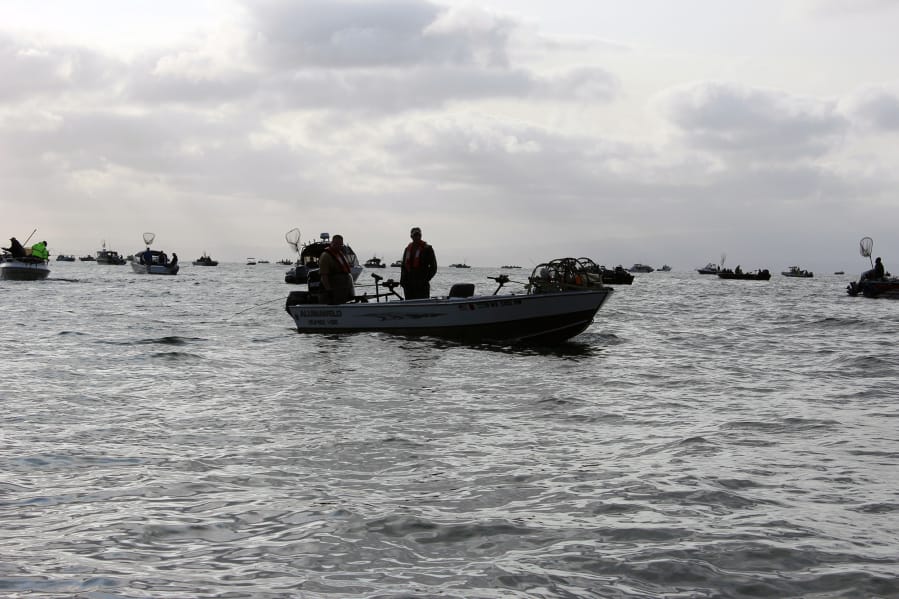The Columbia River has seen its best fall salmon returns since the formation of the warm-water “Blob” in the northern Pacific Ocean that decimated salmon runs from 2014 through 2017.
The stronger returns are a result of better ocean conditions, but does this mean we have turned the corner, or is there still concern about the state of the ocean and the species it supports?
According to a number of scientists the answer is “maybe.” There are still some troubling signs from the ocean data, but it does seem to point to relatively better conditions for at least some of the salmon and steelhead that return to the Columbia basin.
Thomas Buehrens is a senior research scientist with the WDFW and the University of Washington with a focus on the Columbia River salmon runs. He reports that ocean condition indicators have been mixed the last few years, with some trending up while others are trending down. What does that mean for salmon runs in the coming year?
“My best guess is we are not going to have the best year ever,” said Buehrens, “but we are not going to have the worst year ever. And coming out of where we had some really bad years, I think the mixed indicators are something to be optimistic about.
“We are not going to have record runs, but we are just not going to have the widespread fishery closures and we are moving back to normal runs,” he added.
The mass of warm water that formed the Blob in 2014 was extensive and reached from the Northwest coast to Russia. It broke up and dissipated by 2018, but smaller versions have reappeared in the last two years. These were not as big and stayed off the coast, so young salmon that out-migrated in 2018 and 2019 found better conditions.
However, Buehrens explains that the ocean is not just one big habitat.
“We think of the ocean as one thing, not like we think about different streams,” Buehrens said. “It can be good in one area and not good in another area.”
“The coho did well this year, but for steelhead it doesn’t look like they did well,” Buehrens said. “The one-salt fish just didn’t show.”
This year’s one-salt summer steelhead, so called because they spend one winter in the ocean, went out in the spring of 2019, as did the coho salmon that returned this fall in strong numbers. Coho hang along the coast, but steelhead migrate way out to sea. Obviously the coho found what they needed to survive but the steelhead did not.
Meanwhile, two- and three-salt steelhead returns bounced back a little this year.
Data from this summer’s ocean surveys have not yet been analyzed. Also, some surveys did not take place due to Covid-19 restrictions.
Lauri Weitkamp is a research fisheries biologist with the National Oceanic and Atmospheric Administration (NOAA). What she has seen of the 2020 summer ocean conditions leads her to believe that the ocean is improving for salmon, but still has some issues.
“My sense is no, that (2020) is not as extreme,” Weitkamp said. “It’s not a cold year, it is a warm year. But compared with what we saw in 2016, it’s not that bad.”
She explained that the numbers of warm water fish species showing up off the coast of Washington and Oregon this year are not as numerous as in the Blob years, when southern species such as dorado migrated north in strong numbers.
Weitkamp did point to the phenomenon of huge numbers of market squid showing up along the Northwest coast this year. This opportunistic southern species feeds on many of the same things as juvenile salmon, potentially reducing the food available for those fish.
She also noted that the zooplankton community has bounced back and forth between cold-water plankton species, which carry more fats and nutrients, and warm-water species, which provide less nutrition.
The life history of the different salmon and steelhead species is varied, so that the effects of poor and good ocean years show up in a different timeline. For instance, coho spend one winter in the salt water, whereas Chinook spend two to five years at sea. Therefore, coho returns rebound faster than Chinook.
That could be reason for optimism when looking ahead to Chinook returns in the next couple years.
For winter steelhead, however, the poor return of one-salt summer steelhead could mean a more pessimistic outlook. The two-salt winter steelhead that will return to Columbia River tributaries starting in December went out to sea at the same time as the one-salt summer fish.
Buerlens said there is an association between the two.
“I don’t expect to see a real good winter run,” he said. “There’s a chance it could be poor based on those one-salt summer fish.”
Fish run projections are an imperfect art, and there are not many indicators that biologists can tap into that can be applied to steelhead.
“We need better forecasting models for winter steelhead,” Buehrens added.
Ocean indicator modeling is also an imperfect science, but there is no doubt that the extreme warm water that plagued the northern Pacific Ocean from 2014 through 2017 has broken up, and that is good news for salmon, and the fishermen that pursue them.
For more information, see the NOAA ocean conditions summary at: https://www.fisheries.noaa.gov/west-coast/science-data/summary-ocean-indicators-2019
Terry Otto’s Southwest Washington fishing update and forecast can be found as part of Bob Rees’ “The Guides Forecast” at: https://www.theguidesforecast.com/



